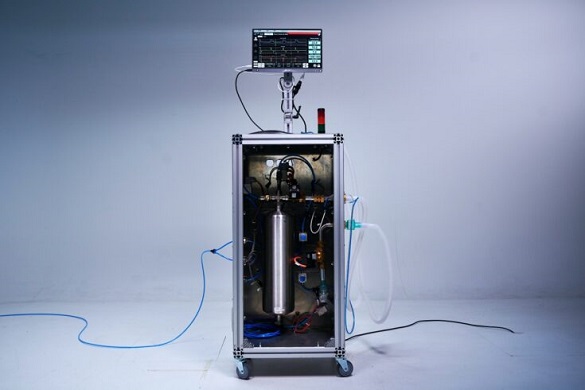Physicists at the University of Liverpool are part of a team of UK scientists awarded £760k funding from UKRI to develop a robust, low-cost ventilator known as the HPLV (High Performance Low Cost Ventilator). This is focussed on helping patients in low and middle-income countries suffering from severe respiratory problems due to Covid-19
Mechanical ventilation is a small but important part of the management of pandemic virus infections which affect the lungs, including SARS-CoV-1, SARS-CoV-2 (COVID-19) and influenza.
Liverpool’s role
Professor Themis Bowcock, a member of the Particle Physics research group at the University of Liverpool, has played a major role the development of the HPLV.
In March 2020, he instigated his collaborators at CERN to design and build a ventilator – the HEV – to help in the battle against Covid-19. HEV utilizes technology developed for the LHCb experiment at CERN. HEV was built with guidance from local hospitals and an international team of medical experts and specialists.
The designs for the CERN HEV (High Energy physics Ventilator) feed directly into the UK’s HPLV project. Liverpool researcher Dr Karol Hennessy, a member of LHCb, spearheads the software development critical to HPLV with a team from STFC.
Professor Bowcock, said: “It is of enormous importance to us that the technology and software techniques we developed for fundamental physics at the Large Hadron Collider will be used to support the international community in the Covid-19 era. This shows that expertise of researchers across the whole UKRI portfolio play a part in tackling urgent and acute challenges faced by humanity.”
Affordable, reliable and easy to use
Ventilators are typically expensive to purchase and maintain, and need considerable training to use. Most also rely on the provision of high-flow oxygen and medically pure compressed air, which may not be readily available in low resource settings.
The HPLV project is co-ordinated by the Science and Technology Facilities Council’s (STFC) Daresbury Laboratory, and will produce and test plans for the creation of an affordable, reliable, safe and easy-to-operate ventilator.
It is anticipated that these plans will be used by a wide variety of manufacturing groups across the world, thereby reducing the need for expensive transportation and maintenance.
The Head of the Technology Department at STFC’s Daresbury Laboratory, Ian Lazarus, is the project lead. He said: “I am proud to be leading this team, in which we have brought together experts from medicine, science, engineering and knowledge transfer with a shared goal to make resilient high quality ventilators available in areas of the world which currently don’t have enough of them.”
International expertise
The project brings together many partners including the University of Liverpool. As well as leadership from Daresbury Lab, teams across STFC will be working on this project, from the Technology Department, the Hartree Centre, ISIS Neutron and Muon Source and the Business and Innovation Department (BID).
STFC will also be working with international partners from the Federal University of Rio de Janeiro (Brazil) and CERN, as well as the University of Birmingham and the Medical Devices Testing and Evaluation Centre (MDTEC).
A common goal
The HEV prototype design, which was developed using research techniques routinely used at CERN, will be re-engineered to make it ready for regulatory approval and manufacture.
HEV team leader and HPLV collaborator, Paula Collins, is part of the LHCb experiment at CERN, said:
“HEV was born at CERN during the first lockdown thanks to a dedicated team of physicists and engineers who adapted their expertise to fight the pandemic.
“We are grateful to our international team of medical advisers who helped us to orient the HEV design towards the needs of low and middle-income countries, and to build a ventilator focused on quality and patient comfort.
“We warmly welcome the HPLV initiative, which will build upon the success of HEV and we look forward to working together with the outstanding HPLV team for our common humanitarian goal.”
A team effort
During the HPLV project, partners based in Brazil will identify difficulties encountered when ventilating patients and pass that information to the design team, while regulatory experts in the UK will also provide guidance on this re-engineering activity.
The STFC BID team will work closely with their counterparts in CERN’s Knowledge Transfer group to identify industrial partners who will manufacture and supply the HPLV ventilators.
The project will run for 6 months from October 2020 to April 2021 with a small amount of funding in the following 12 months to support the transfer of the HPLV technology to industrial partners.
The funding has been awarded by UK Research and Innovation (UKRI) through the Global Challenges Research Fund (GCRF), which looks to support scientists to develop solutions to mitigate the short and long-term social, economic and health impacts of the pandemic.
Professor Bowcock, is a member of the ‘CERN against Covid’ committee and the WHO Expert Respiratory Panel.
Image credit: CERN
